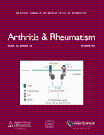Evidence for a different anatomic basis for joint disease localization in polymyalgia rheumatica in comparison with rheumatoid arthritis
Abstract
Objective
The anatomic basis for joint disease localization in polymyalgia rheumatica (PMR) is poorly understood. This study used contrast-enhanced and fat suppression magnetic resonance imaging (MRI) to evaluate the relationship between synovial and extracapsular inflammation in PMR and early rheumatoid arthritis (RA).
Methods
Ten patients with new-onset PMR and 10 patients with early RA underwent dynamic contrast-enhanced MRI and conventional MRI of affected metacarpophalangeal (MCP) joints. Synovitis and tenosynovitis were calculated based on the number of enhancing voxels, initial rate of enhancement, and maximal enhancement of gadolinium diethylenetriaminepentaacetic acid (Gd-DTPA). Periarticular bone erosion and bone edema were scored according to the OMERACT (Outcome Measures in Rheumatology Clinical Trials) scoring system in both groups. The degree of extracapsular Gd-DTPA enhancement was assessed in both conditions using semiquantitative scoring.
Results
No significant differences were seen in the volume of synovitis (P = 0.294), degree of flexor tenosynovitis (P = 0.532), periarticular erosions (P = 0.579), or degree of bone edema (P = 0.143) between RA and PMR joints. However, despite comparable degrees of synovitis, the proportion of MCP joints showing extracapsular enhancement was higher in the PMR group (100%) than in the RA group (50%) (P = 0.030). One PMR patient, but none of the RA patients, had bone edema at the capsular insertion.
Conclusion
Despite degrees of synovitis and tenosynovitis comparable with those in RA, PMR-related hand disease is associated with prominent extracapsular changes, suggesting that inflammation in these tissues is more prominent than joint synovitis, which is common in both conditions. This suggests that the anatomic basis for joint disease localization differs between RA and PMR.




